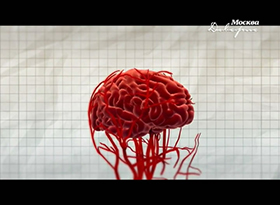ПУБЛИКАЦИИ
Moyamoya syndrome associated with neurofibromatosis Type 1: perioperative and long-term outcome after surgical revascularization Clinical article
- Создано 07.04.2013 17:14
OBJECT
Children with neurofibromatosis Type 1 (NF1) can present with progressive arteriopathy of the branches of the internal carotid artery consistent with moyamoya syndrome. Clinical symptoms, radiographic evidence of ischemia, and the potential for disease progression may necessitate surgical revascularization to minimize the risk of stroke and progressive neurological deficits. This study aims to evaluate the presentation and surgical outcomes of these patients by reviewing clinical, radiographic, and angiographic data.
METHODS
A retrospective review was conducted of clinical and radiographic records of all children with NF1 who were diagnosed with moyamoya syndrome and underwent surgical revascularization between January 1988 and April 2012 at Boston Children's Hospital.
RESULTS
During this period, 39 patients (27 female and 12 male, ages 0.2–19.3 years) had both NF1 and moyamoya syndrome, of whom 32 underwent surgical revascularization with pial synangiosis. Of the 32 patients treated by surgical revascularization, 21 (66%) manifested ischemic symptoms and 18 (56%) had radiographic evidence of prior stroke at the time of moyamoya diagnosis. In total, 25 of 32 patients developed neurological symptoms prior to surgical intervention. Only 1 patient presented with hemorrhage. The average age at first surgery was 8.1 years (range 0.5–15.6 years). Perioperative complications in the first 7 days included stroke (n = 2), transient ischemic attack (n = 1), and infection (n = 1). Twenty-two patients had more than 6 months of follow-up, with an average clinical and radiographic postoperative follow-up period of 80.2 months (range 9.4–257.1 months). Of those patients with long-term follow-up, 21 (95%) of 22 demonstrated stable or improved neurological status despite radiographic evidence of moyamoya progression in 48% of patients.
CONCLUSIONS
Children with NF1-associated moyamoya syndrome are often diagnosed prior to development of fixed neurological deficits as a consequence of imaging studies obtained for other manifestations of NF1. The clinical, radiographic, and angiographic features in this population are comparable to primary moyamoya disease, with the exception of patients treated with cranial irradiation, who may be at greater risk for both stroke as well as perioperative complications. Despite radiographic evidence of progressive stenosis in 48% of patients, nearly all demonstrated stable or improved neurological status after surgical revascularization. Surgical revascularization for children with NF1 appears safe and is protective against further ischemic and neurological damage, with a 27-fold reduction in stroke rate.
- Удаление каверномы глубинных отделов правого полушария
- Клипирование de novo образованной аневризмы левой СМА
- Клипирование крупной частично тромбированной аневризмы
- Удаление каверномы в сочетании с амигдало-гиппокампэктомией
- Иссечение АВМ после частичной эмболизации композицией onyx
- Клипирование гигантской аневризмы СМА с применением методики ВАК





